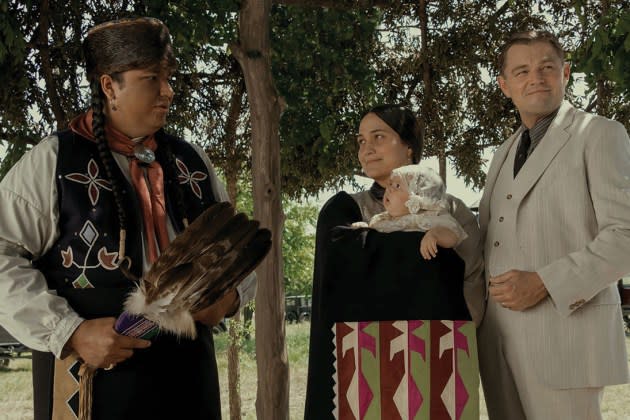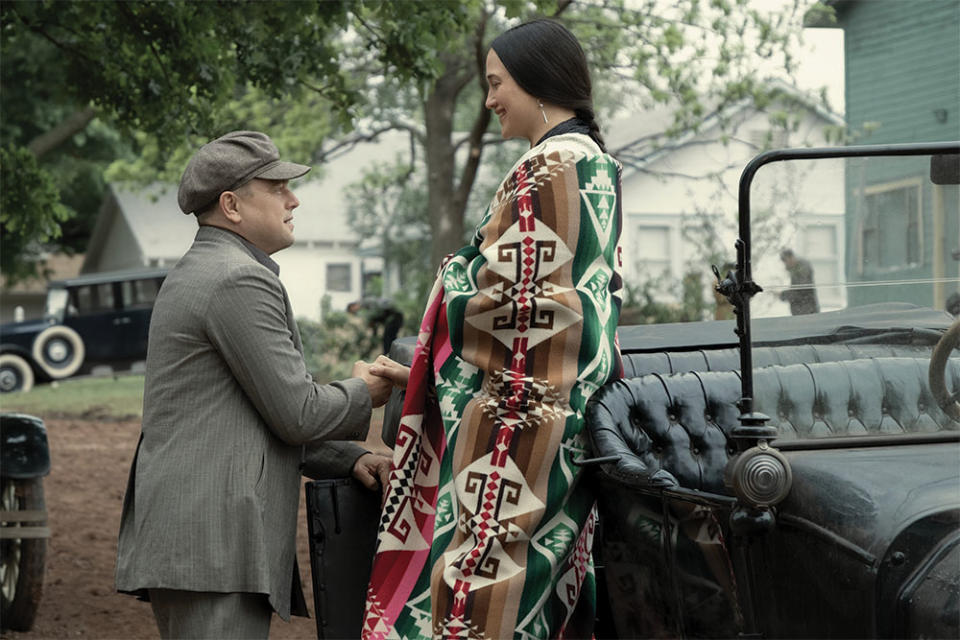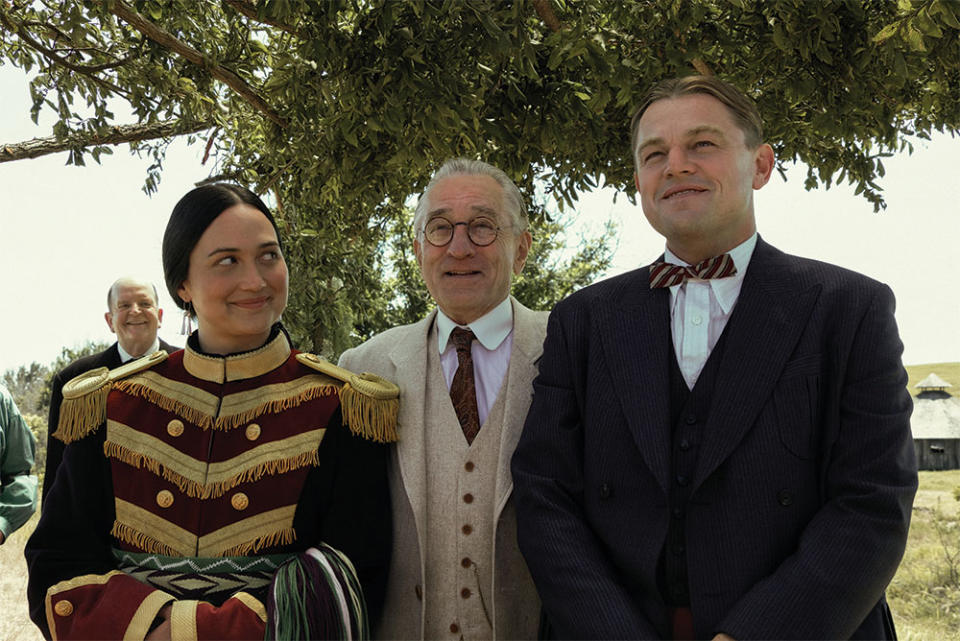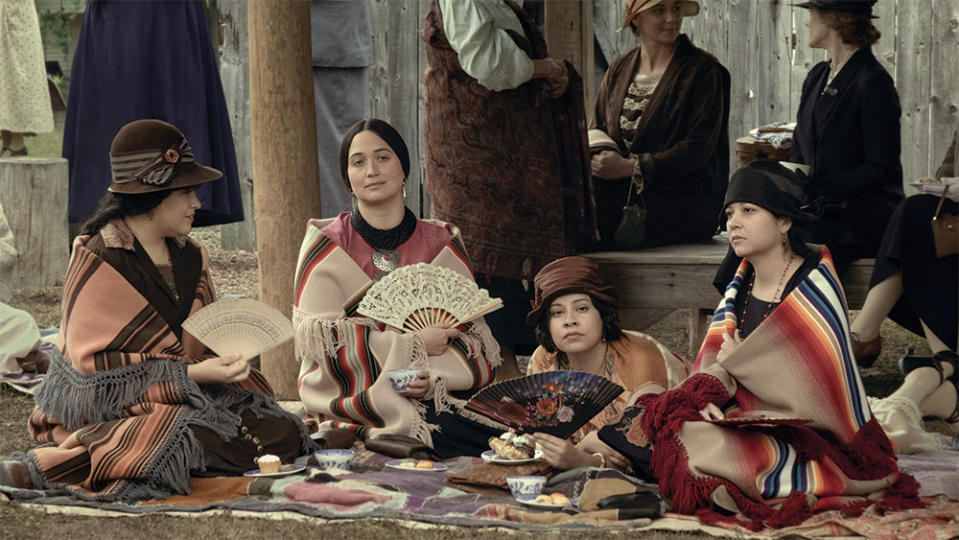‘Killers of the Flower Moon’ Costume Designer Breaks Down Hidden Messages in Heirloom Patterns and ’20s-Era Suits
- Oops!Something went wrong.Please try again later.
- Oops!Something went wrong.Please try again later.

For Martin Scorsese’s Killers of the Flower Moon, costume designer Jacqueline West immersed herself in researching early-1920s denizens of Osage County, Oklahoma. She visited museums commemorating plundering oil tycoons and watched rare black-and-white home movies commissioned by Osage families, wealthy from retaining mineral rights to their oil-rich reservation. Osage costume consultant Julie O’Keefe ensured the authenticity and nuanced storytelling of traditional clothing and materials, which endure long after the tribe’s forced relocation from Missouri to Oklahoma in 1872.
“I had these 10-foot boards of townspeople, on every level, all the way around my warehouse,” says West about designing the introductory sequence in which World War I veteran Ernest Burkhart (Leonardo DiCaprio) arrives in bustling Fairfax and encounters the two worlds he soon infiltrates. Suited white merchants and disheveled fieldworkers seek their fortune, as Osage Nation members don attire representing their cultural pride and wealth. Patterned blankets pristinely wrapped around tailored suits, moleskin buckle-back pants and en vogue Roaring ’20s fashion telegraph their status as the richest people per capita on earth.
More from The Hollywood Reporter
Daytime Emmys: 'General Hospital,' 'The Kelly Clarkson Show' Among Top Winners
'Beckham,' 'Carpool Karaoke' Among 2024 PGA Sports, Children's and Short Form Nominees
The fates of Ernest’s future wife, Mollie Kyle (Lily Gladstone), and her sisters represent the first Osage generation’s spectrum of experiences, from being forcibly separated from their families to attend government-run boarding schools, to straddling the white system that’s seeking to steal from their oil-rich heritage. “I use the sisters as a microcosm,” says West. “Traditional” Mollie — like her mother, Lizzie Q (Tantoo Cardinal) — wears “classic” Osage blouses in calico or satin, trimmed with hand-done ribbon. To accurately make Mollie’s shirts, West studied photos of the real sisters, museum pieces and Osage family heirlooms that were on loan. William “Kugee” Supernaw, the owner of Supernaw’s supply store, handcrafted Mollie’s treasured seed-bead necklace and silver circular Wabonka pins, cornerstones of Osage attire.
West based “modern” Anna’s (Cara Jade Myers) flapper garb on Natacha Rambova, Cecil B. DeMille’s fashion-trailblazing costume designer. Minnie (Jillian Dion) and Reta (Janae Collins), marrying outside the tribe, are “degrees of” traditional Osage representation. But blankets — Osage status symbols and gestures of generosity — connect the community. “The power suit of the ’20s,” says West, who had Pendleton, maker of trade blankets for Native Americans since the early 1900s, re-create period-correct designs and labels. O’Keefe invited Osage artisans Janet Emde, Ruth Shaw and Anita Fields to handcraft traditional ribbon work.
O’Keefe explains that the blankets communicate stories through distinctive colors and patterns, and method of wrapping. Preparing for Lizzie Q’s death, Mollie precisely folds her black blanket up over her shoulder on one corner “out of respect for her dying mother, and in a utilitarian fashion, to comb her mother’s hair and tend to her as a caretaker,” says O’Keefe.
Ernest marries Mollie — at the direction of his uncle William King Hale (Robert De Niro), — and wraps a blanket around his waist, while Mollie’s ornate one boasts 27 yards of ribbon. West and O’Keefe also personalized each sister’s wedding coat with unique designs, like Minnie’s lotus flowers, and elaborate finger-woven belts. “We tried to get all of the elements from Osage art into each one,” says West.
The nefarious Hale telegraphs integrity-for-show through a tweedy beige three-piece suit. For his suiting, fedoras and cutting-edge driving goggles, West took inspiration from Ronald Colman’s land developer character in the 1926 Western The Winning of Barbara Worth. “William Hale has all these other people doing his dirty work,” says West, whose costumes for him subvert the Western cliché of bad guys in black and good guys in white. “So it was subliminal. He’s in a light suit when he’s [pretending to be] a friend of the Osage, and other times, he’s in a dark suit, like the devil.”
Enjoying his newfound riches, Ernest now wears his oft-proclaimed love of money through beautiful three-piece suits, custom-made by United American Costume House. West based his wardrobe upgrade on Hollywood’s first Western star, Tom Mix, famed for his Stetson hats, diamond-trimmed cowboy boots and bespoke suits from Pawhuska, Oklahoma. Ernest also incorporates reminders of his connection with — or incursion into — the Osage: a finger-woven band decorating his Stetson and a Tom Mix-inspired striped jacket made from a Pendleton blanket. West imagined they were gifts from Mollie. “She’s traditional,” says West. “She might claim him with little touches of Osage art.”



This story first appeared in a November standalone issue of The Hollywood Reporter magazine. Click here to subscribe.
Best of The Hollywood Reporter
Eight Actors Who Have Played Willy Wonka in Films and on Broadway
Martin Scorsese’s 10 Best Movies Ranked, Including 'Killers of the Flower Moon'

